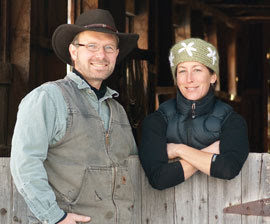Coyotes Under Fire Predator-Friendly Pioneers
New breed of ranchers prefers nonlethal control to protect sheep
"If we lose 1 or 2 percent, that's the cost of doing business."
Ranchers like Richard Harjes, though, have embraced nonlethal tactics. When he and his wife, Katy, started raising sheep in 2008, their Montana ranch lay in a boxed canyon dense with coyotes. There was a pack to the north, a pack to the east, and a pack to the south. Looking for a way to avoid killing coyotes or the mountain lions or black bears living around their property, the Harjes discovered the type of livestock guardian dogs long used in Europe. The first year, when they had only one dog borrowed from a neighboring rancher, losses were steep—around 8 percent of their 500-animal herd, half from mountain lions and half from coyotes. Harjes would see the carrion birds in the pasture and know, instantly, he'd lost a sheep to a coyote (the mountain lions typically carried the bodies off).
The Harjes might have gotten discouraged and quit. Instead, they bought five dogs weighing 120 to 150 pounds apiece (to the coyotes' average 25 to 30), who were bred and trained to bond with sheep and fiercely defend them. The second year losses fell to 4 percent, the third year to just 1.
"You create this standoff with dogs—the dogs are constantly peeing on things ... and walking along the fences," says Harjes, who figures he's training his local coyote packs as well as the dogs. One day he stepped out of his house to see a coyote in the pasture. In the same moment, "the [dog] did a quarter-mile sprint and the coyote took off like a shot and just made the fence."
Maybe, Harjes says, someday he will have to kill a coyote to protect his sheep. But it will be as a last resort. And so at night he listens, happily, to the coyotes' distinctive yipping and howling. Sometimes, if they're real close, he gets nervous and goes to check his sheep. Mostly, though, he trusts his dogs and enjoys the coyotes' wild songs. "If we lose 1 or 2 percent," he says, "that's the cost of doing business."












No comments:
Post a Comment